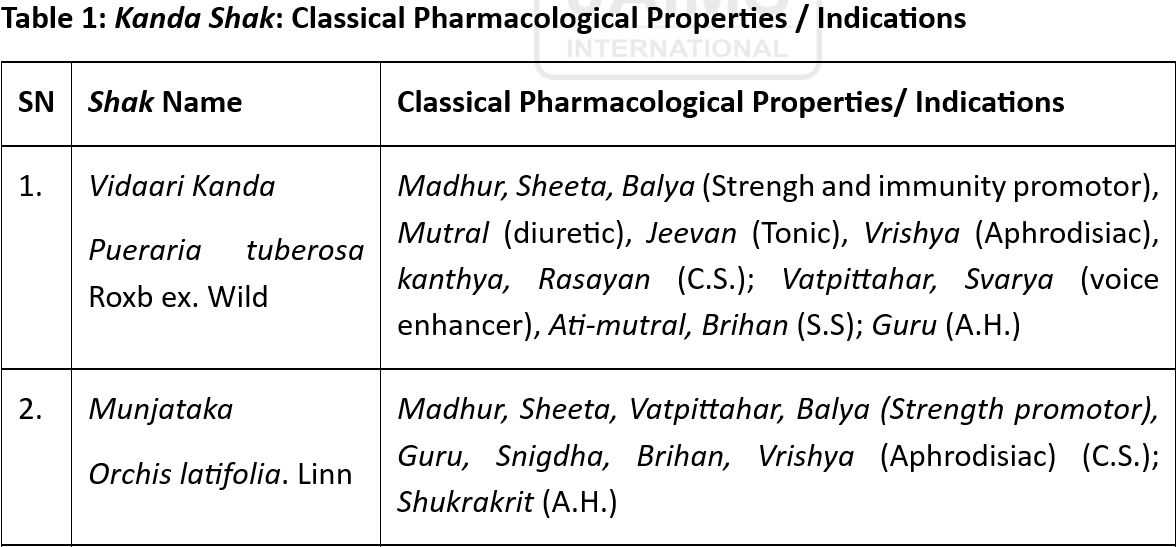Neutraceutical Potential of Some Kanda Shak (Tuberous vegetables): A Review
DOI:
https://doi.org/10.21760/jaims.10.9.31Keywords:
Ahar, Kanda Shak, Tubers, Brihattrayi, Nutraceutical valueAbstract
Ahar is regarded as Mahabheshaja in Ayurveda. It refers to any substance that is chewed and ingested for nutritional and energy purposes. Shak (vegetables) are included in the diet as essential components by ancient sages, contemporary ayurvedic and modern medical scientist / nutritionists. In Charak Samhita and Ashtanga Hridaya, tubers are mentioned under Ahar Varga and Acharya Sushrut especially explained it in Kanda Varga (Group of tuberous vegetables). Tuberous vegetables boast several noteworthy properties that contribute to their nutritional value as they are rich in all essential dietary components like carbohydrates, proteins, fats, vitamins and dietary fibres. In addition, tubers also contain vitamins, minerals, trace elements and biologically active molecules that function as antioxidants, phytoestrogens, and anti-inflammatory agents. Consumption of these tubers may play a role in preventing diseases in which free radicles are involved such as cancer, ageing, cardiovascular diseases. Present review is an attempt to explore nutraceutical potential of Kanda Shak described in Brihattrayi and a comparative analysis with their nutraceutical composition explored by modern analytical studies.
Downloads
References
Sharma H. Kashyap Samhita Khilasthan Vriddhajivakiya Tantra, Chapter 4 Yushnirdeshiya Adhyaya. 5th ed. Varanasi: Chaukhambha Sanskrit Sansthan; 1998.
Shastri K. Charaka Samhita of Agnivesh, Sutrasthan 27/67. Vidyotini Hindi Commentary. Part 1. Varanasi: Chaukhambha Sanskrit Sansthan; 2014.
Shastri A. Sushruta Samhita of Maharshi Sushruta, S.S. 46/4–450. Ayurvedtatvasandipika Commentary. Part 1. Reprint ed. Varanasi: Chaukhambha Bharti Academy; 2012.
Upadhyay Y. Ashtanga Hridayam, Sutrasthan 6/112. Vidyotini Hindi Commentary. Reprint ed. Varanasi: Chaukhambha Sanskrit Sansthan; 1999.
Bhagyalaxmi CV, Huddar SH, Kumar EA. Review on Shaka Varga with special reference to Brihattrayi. J Ayurveda Integr Med Sci. 2023 Jul;8(7). ISSN: 2456-3110.
Chunekar KC. Bhavaprakash Nighantu: Indian Materia Medica of Acharya Bhav Mishra, 6/1. Reprint ed. Varanasi: Chaukhambha Bharati Academy; 2024. p. 650.
Shastri K. Charaka Samhita of Agnivesh, Sutrasthan 25/38. Vidyotini Hindi Commentary. Part 1. Varanasi: Chaukhambha Sanskrit Sansthan; 2014.
Indian Council of Medical Research. Indian Medicinal Plants. Vol. 18. New Delhi: ICMR; 2018. p. 553.
Thakur BS, Chunekar KC. Glossary of Vegetable Drugs in Brihattrayi. Reprint ed. Varanasi: Chaukhambha Amarbharati Prakashan; 2015. p. 160.
Indian Council of Medical Research. Indian Medicinal Plants. Vol. 9. New Delhi: ICMR; 2018. p. 456.
Sharma PV. Dravyaguna Vigyana. Vol. II (Vegetable Drugs), No. 244. Reprint ed. Varanasi: Chaukhambha Bharati Academy; 2022. p. 585.
Sharma PV. Dravyagunakosha (Dictionary of Ayurvedic Terms). Pratham Dravya Khandam. Reprint ed. Varanasi: Chaukhambha Orientalia; 2003. p. 81.
Chunekar KC. Bhav Prakash Nighantu: Indian Materia Medica of Shri Bhav Mishra. Pushpa Varga. Reprint ed. Varanasi: Chaukhambha Bharati Academy; 2024. p. 468.
Indian Council of Medical Research. Indian Medicinal Plants. Vol. 11. New Delhi: ICMR; 2018. p. 593.
Sharma PV. Dravyaguna Vigyana. Vol. II (Vegetable Drugs), No. 245. Reprint ed. Varanasi: Chaukhambha Bharati Academy; 2022. p. 586.
Sharma PV, Sharma GP. Kaiyadeva Nighantu: Pathyaapathya Vibodhakah. Reprint ed. Varanasi: Chaukhambha Orientalia; 2017. p. 644.
Chunekar KC. Bhav Prakash Nighantu: Indian Materia Medica of Shri Bhav Mishra. Pushpa Varga. Reprint ed. Varanasi: Chaukhambha Bharati Academy; 2024. p. 471.
Chunekar KC. Bhav Prakash Nighantu: Indian Materia Medica of Shri Bhav Mishra. Pushpa Varga. Reprint ed. Varanasi: Chaukhambha Bharati Academy; 2024. p. 468.
Sharma PV, Sharma GP. Kaiyadeva Nighantu: Pathyaapathya Vibodhakah. Reprint ed. Varanasi: Chaukhambha Orientalia; 2017. p. 641.
Chunekar KC. Bhav Prakash Nighantu: Indian Materia Medica of Shri Bhav Mishra. Shakvarga. Reprint ed. Varanasi: Chaukhambha Bharati Academy; 2024. p. 685.
Thakur BS, Chunekar KC. Glossary of Vegetable Drugs in Brihattrayi. Reprint ed. Varanasi: Chaukhambha Amarbharati Prakashan; 2015. p. 40.
Ojha J, Mishra U, editors. Dhanvantari Nighantu: Hindi Translation and Commentary. 1st ed. Varanasi: Adarsh Vidya Niketan; 1985. 67/132. p. 217.
Sharma PV, Sharma GP. Kaiyadeva Nighantu: Pathyaapathya Vibodhakah. Reprint ed. Varanasi: Chaukhambha Orientalia; 2017. p. 643–4.
Malviya A, Gupta R, Porte SM. Critical review on Vidarikanda (Pueraria tuberosa DC.): an Ayurvedic herb. Int J Ayurveda Pharma Res. 2016 Feb;4(2).
Anjum AA, Tabassum K, Ambar S. Medicinal properties and uses of Salabmisri (Orchis latifolia Linn): a literary review. J Phytopharmacol. 2019;8(1):18–20.
Baah FD, Maziya-Dixon B, et al. Nutritional and biochemical composition of D. alata (Dioscorea spp.) tubers. J Food Agric Environ. 2009 Apr;7:373–8.
Anand A, Tiwari A, et al. Nutritional composition and antioxidative stress properties in boiled tuberous rhizome of Neel Kamal (N. nouchali Burm. f.). Indian J Nat Prod Resour. 2019 Mar;10(1).
Sruthi A, Panjikkaran ST, et al. Insights into the composition of lotus rhizome. J Pharmacogn Phytochem. 2019;8(3):3550–5.
Singh LR. Medicinal and ecological potential of Kasheruk (Scripus grossus): a review. J Harmon Res Pharm. 2017;6(3):51–3.
Singh M, Sharma R. Shringataka: a pharmacological review. World J Pharm Res. 2024 Jun 27;13(16):222–30.
Abarike ED, Abobi SM, et al. Exploring the nutrient potential of Nymphaea alba (Water Lily), for use as livestock feed. Int J Dev. 2015 Aug;2(1). Available from: http://www.udsijd.org
Velavan S, Nagulendran KR, et al. The chemistry, pharmacological and therapeutic applications of Asparagus racemosus: a review. Pharmacogn Rev. 2007 Jul–Dec;1(2).
Indian Council of Medical Research. Indian Medicinal Plants. Vol. 9. New Delhi: ICMR; 2018. p. 456.
Basu S, Das M, Sen A, Choudhury UR, Datta G. Analysis of complete nutritional profile and identification of bioactive components present in Alocasia indica tuber cultivated in Howrah District of West Bengal, India. Asian Pac J Trop Med. 2014;7(Suppl 1):S527–33. doi:10.1016/S1995-7645(14)60285-6.
Raja MK, Sethiya NK, Mishra SH. A comprehensive review on N. stellata: a traditionally used bitter. J Adv Pharm Technol Res. 2010;1(3):311–9. doi:10.4103/0110-5558.72424.
Gupta AJ, Kaldate S, et al. Onion: nutritional and nutraceutical composition and therapeutic potential of its phytochemicals assessed through preclinical and clinical studies. J Funct Foods. 2025 May;129:106889. doi:10.1016/j.jff.2025.106889.
Upadhyay RK. Garlic: a potential source of pharmaceuticals and pesticides: a review. Int J Green Pharm. 2016 Jan–Mar;10(1). doi:10.22377/ijgp.v10i1.609.
Gamba M, Asllanaj E, et al. Nutritional and phytochemical characterization of radish (Raphanus sativus): a systematic review. Trends Food Sci Technol. 2021 May;113(11). doi:10.1016/j.tifs.2021.04.045.
Datta G, Basu S, et al. Analysis of complete nutritional profile of Amorphophallus campanulatus tuber cultivated in Howrah District of West Bengal, India. Asian J Pharm Clin Res. 2014 Jun;7(3). ISSN: 0974-2441.
Motegaonkar S, Shankar A, et al. A comprehensive review on carrot (Daucus carota L.): the effect of different drying methods on nutritional properties and its processing as value-added food. Sustain Food Technol. 2024 May 24;2(3):667–8.
Field agaric mushrooms (Agaricus campestris) in Botanic Gardens of Komarov Botanical Institute. Saint Petersburg, Russia; 2013 Sep 9.
Singh S, Sharma N, Singh N. Hedychium spicatum: boon for the medicinal field in future. Bull Environ Pharmacol Life Sci. 2018 Oct;7(11):188–92. ISSN: 2277-1808.

Published
How to Cite
Issue
Section
License
Copyright (c) 2025 Mayuri Anil Shembekar, Hari Shanker Mishra, Atul Babu Varshneya, S.S. Bedar

This work is licensed under a Creative Commons Attribution 4.0 International License.














